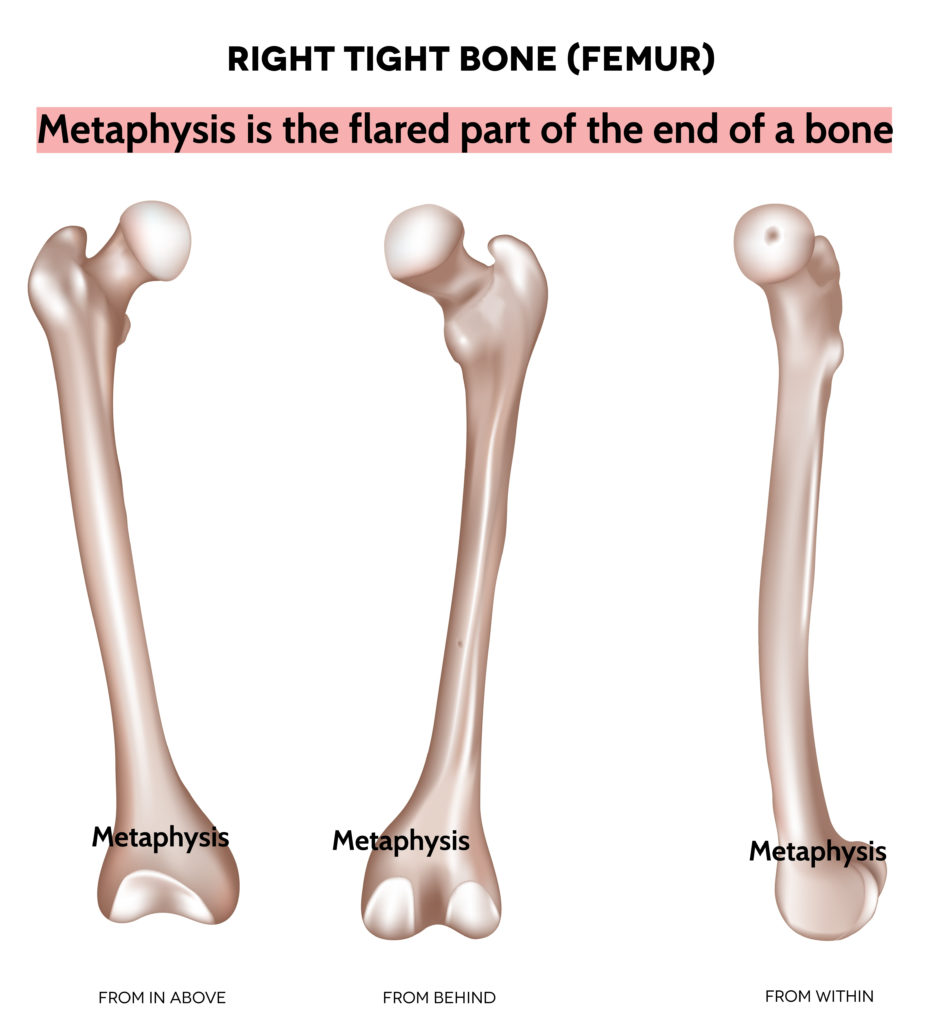Osteomyelitis refers to an infection in the bone. In children, an infection often makes its way to the bone via blood. This can be a result of an infection in the tooth, a urinary tract infection, or even an upper respiratory infection.
When bacteria from a different location in your body, for example, bacteria from a tooth infection or a urine infection get access to the bloodstream, they can spread and multiply in a part of the bone called the metaphysis which is the flared part of the bone as is seen in the picture below.
Due to the unique anatomical structure of the metaphysis, the bacteria are able to grow and then spread along the whole bone.
This article will show you the causes of osteomyelitis, the signs, and symptoms of bone infection, and how bone infection is investigated and treated.

Causes of osteomyelitis
Certain kinds of bacteria are likely to cause osteomyelitis in specific age groups.
| Age group | Type of Bacteria |
| Babies | Group B streptococci |
| Children 2 to 4 years | Staphylococcus aureus (present in all age groups) |
| Adolescents | Staphylococcus aureus |
| Children with sickle cell anaemia | Salmonella species |
Do you need to see a paediatric orthopaedic surgeon?
Classification of osteomyelitis
The common classification is based on the timing from onset of symptoms
– Acute osteomyelitis
The onset of symptoms from 0 to 48hours
– Subacute osteomyelitis
The onset of symptoms from 48hrs to 2weeks
– Chronic osteomyelitis
The onset of symptoms is beyond 2 weeks.
Signs and symptoms of osteomyelitis
1. Fever; temperatures of more than 38degrees celsius
2. Pain of the affected leg or hand
3. Redness of the affected limb
3. Swelling of the affected limb
4. Inability to walk on the affected leg
5. Pain on moving the adjacent joint.
Chronic osteomyelitis
In addition to the above symptoms, chronic osteomyelitis can also present with
- Small opening on the skin ( also called a sinus) with pus discharge
- Bone Fractures of the infected bone
- Bone poking out through the skin.
What other conditions can happen together with the osteomyelitis
- Septic arthritis.
Septic arthritis is an infection of the joint. Infection in the bone can sometimes cross to the joint and lead to infection in the joint.
Children with septic arthritis may have the same features as those with osteomyelitis but they are more likely to complain of pain plus an inability to move the joint.
How is bone infection/osteomyelitis diagnosed in children?
Doctors can confirm the presence of osteomyelitis by doing both blood tests and radiological tests.
Blood tests
A full blood count or complete blood count will show an increase in the number of total white blood cells.
CRP and ESR and inflammatory markers that are elevated in the presence of infection
Radiological tests
- X-rays will show changes in bone that could point toward infection.
X-rays may not be useful in acute (very early) infection as they might show a normal bone.
- MRI scans are very sensitive, especially in early infection, and will show areas of infected bone appearing different from the normal bone.
- Bone scans. Though rarely used to check for infection because of the amount of radiation, these scans will show hot and cold areas in the bone. Areas of infection in the bone will be hot because of increased metabolism in the bone.
Treatment of osteomyelitis
Acute osteomyelitis
Antibiotics are the first line of treatment for acute osteomyelitis.
However even with acute osteomyelitis, sometimes, your doctor will recommend surgery if there are signs of pus collection in areas surrounding the bone which can not be cleared with antibiotics.
Chronic osteomyelitis
In addition to antibiotics, most chronic osteomyelitis will require surgery to remove the dead bone and clean out the infection in the bone.
In conclusion, osteomyelitis is an infection of the bone. It can be categorized into acute, subacute, and chronic. Osteomyelitis will lead to fever, swelling, and pain in the affected bone, and treatment of bone infection is dependent on the classification.
